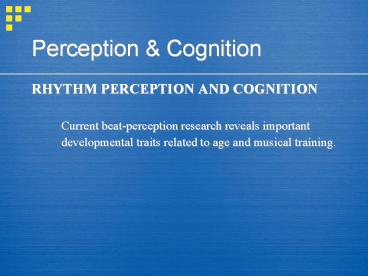Perception PowerPoint PPT Presentation
1 / 10
Title: Perception
1
Perception Cognition
- RHYTHM PERCEPTION AND COGNITION
- Current beat-perception research reveals
important developmental traits related to age and
musical training.
2
Perception Cognition
- RHYTHM PERCEPTION AND COGNITION
- Drake, Jones, and Baruch (2000) examined the
relationship between subjects natural
beat-tapping rates and the tempi at which they
most consistently perceive and reproduce the beat
in response to music. - Participants were asked to tap at a
comfortable rate - Four- and six-year-olds tapped at 150 beats per
minute (bpm) - Eight- and ten-year-olds tapped more slowly, at
around 110-120 bpm - Adults tapped at about 100 bpm.
- Musically trained subjects of all ages tapped
significantly slower than their same-age peers. - Conclusion spontaneous tapping rates slow
significantly as a result of increasing age and
musical training.
3
Perception Cognition
- RHYTHM PERCEPTION AND COGNITION
- Drake, Jones, and Baruch (2000) also concluded
that - listeners of all ages tend to synchronize with
the beat at slower tempi than they spontaneously
tap a beat without any stimulus. - Geringer, Duke, and Madsen (1992) found that
musicians tend to identify a beat in the 60-120
bpm range. When the musical stimuli led them
outside this range, they tended to double or
halve the tapping rate so that the beat tapping
again fell within this comfortable range. Drakes
(1998) research supports this conclusion,
indicating that most adult listeners focus on an
intermediate beat tempo around 100 bpm.
4
Perception Cognition
- Perception of Metric Organization
- Povel formulated a beat-based model that
proposed that the perception of rhythmic
sequences depends on two steps - first, the segmentation of the sequence into
parts of equal length (beats), based on the
detection of regularly occurring accents - second, the identification of individual events
as specific subdivisions of these beats into a
small number (usually two or three) of equal
parts. (Clarke, 1999, p. 483)
5
Perception Cognition
- Perception of Metric Organization
- Dowling (1999) highlights evidence of this
hierarchical organization even in very young
children - The picture that emerges of the development of
rhythmic organization is that a multilevel
structure appears early and that by the age of 5,
the child is quite sophisticated. Already the
spontaneous songs of a 2-year-old show two levels
of rhythmic organization, the beat and rhythmic
subdivisions (often speech rhythms) overlaid on
that, and the 5-year-old follows the same
hierarchical organization in tapped
reproductions. (p. 618)
6
Perception Cognition
- Perception of Metric Organization
- Drake (1993) found 5-year-olds able to perceive
and reproduce rhythm sequences utilizing the beat
and both binary and ternary subdivisions, with
binary examples being somewhat easier. By the age
of 7, children are able to reproduce complex
rhythm patterns nearly as well as adult
non-musicians. Clearly, school-age children
perceive and comprehend two levels of rhythm the
beat and the beat-subdivision.
7
Perception Cognition
- Perception of Metric Organization
- Drakes research demonstrates that more
experienced listeners eventually focus on a third
level of meter beat groupings. Jones (1985)
analysis of five prominent theories of meter
perception supports this position. His analysis
concluded that metric groupings occur at the
level of the basic beat, as well as at levels of
subdivisions and multiples of that beat (p. 54).
8
Perception Cognition
- These three levels beat, subdivision of the
beat, and grouping of beats combine to
establish the widely accepted definition of meter
appearing in New Grove Dictionary of Music and
Musicians (London, 2001, p. 531) - Metres may be categorized as duple or triple
(according to whether the beat or pulse is
organized in twos or threes) and as simple or
compound (whether those beats are subdivided into
duplets are triplets). The four basic metric
categories are shown in Table 1. - Basic metric categories
- Binary pattern of beats
Ternary pattern of beats - Subdivision by twos simple duple 2/4,
4/8 simple triple 3/4, 3/2 - Subdivision by threes compound duple
6/8 compound triple 9/8 - Note that the compound metres are compounded
as a result of the binary orthography of Western
durational notation in order to use a standard
note form for the ternary subdivision, one must
use a dotted value for the beats themselves.
9
Perception Cognition
- Compound Meter Perception vs. Notation
- 6-year-olds best perceive and synchronize their
tapping to the beat at about 112 bpm. - In compound meter, therefore, young children will
tend to perceive the dotted-quarter note as the
beat until these notes occur at a slow enough
rate that the eighth-note division begins to more
closely match this natural reference level. This
does not happen until the tempo of the
dotted-quarter note falls significantly below 60
bpm. By 50 bpm, the eighth-note pulse is at 150
bpm closer to 112 bpm than the dotted-quarter
pulse. Only then will children begin to focus on
the eighth-note pulse as the beat.
10
Perception Cognition
- Compound Meter Perception vs. Notation
- For older and musically trained learners who tend
to perceive beats at slower rates than these
young children, this transition will typically
not occur until the tempo of the dotted-quarter
falls below 35 bpm. Given the fact that the
overwhelming majority of compound-meter music
calls for a tempo at which the dotted-quarter
note exceeds 50 bpm, any practical rhythm
pedagogy must prepare young students to
eventually identify and label the dotted-quarter
note as the beat in compound meters.

